The group exited the boat and trudged up the muddy hill toward the site’s tambo complex, each member preparing to call dibs on whichever tambo they liked best. A few of the members had been here before and selected “their” tambo, others like myself were new and just picked one at random. My tambo was really nice. A great view out toward the rainforest, and two beds (I was lucky enough to secure a tambo to myself) with mosquito netting. This would be my home away from home for a few days. Matt and Alan Ignoffo stayed in a tambo directly across from me.
Where I slept
Main building
The first thing I noticed as the sun began to set was the impressive assemblage of large and attractive “bugs”. Within a hundred yards of my tambo, there was something else lurking around every corner and I began suffering from a major case of overstimulation. Huge millipedes, centipedes, stick insects, cockroaches, tarantulas, wandering spiders, katydids, and more. Beetles of all shapes, sizes, and colors buzzed about. Neat lines of ants appeared out of nowhere, and moths would occasionally get caught between my glasses and my eyeballs, a couple of times into my mouth. But as eclectic as this army of arthropods was, its presence was not felt quite like that of the mosquitoes.
Oh, the mosquitoes.
In truth, the mosquitoes weren’t THAT bad. I’ve experienced worse situations elsewhere including within the United States. But as you may imagine, they were a force to be reckoned with.
Large roach (no, this is not my toothbrush)
And then, there were the night wasps.
The night wasps are as advertised - active by night, and defensive by night. They do not like people in their space, and they really don’t like flashlights all up in their business. They will let you know how they feel, by getting in your face and then stinging you as you do the impromptu wasp boogie you never knew you were capable of. If you can make it through a couple of weeks in the Amazon without being stung, as I did, it’s actually kind of funny. Those who have felt the scorn of the night wasp suffer a sort of hilarious PTSD wherein panic and mania take over at the sight of wasps, and to the annoyance of others, I laughed. I’m sorry. One day I’ll be stung, and I will expect others to laugh at me.
The first member of the expedition to be stung was Matt Ignoffo. He was stung on the back of the neck during the very first excursion at Madre Selva. It didn’t sound good at all.
Matt and Alan on a particularly long, rainy night
But all of that aside, Madre Selva was a haven for snakes. “Oh, such snakes!” as Robert Kennicott once so gleefully declared. Our forest hikes turned up quite a bounty. The first of note was a beautiful Erythrolamprus reginae, or royal ground snake. Among my all-time favorite genera, Erythrolamprus contains some of the most beautiful snakes in South and Central America.
Erythrolamprus reginae
The first of at least four Helicops angulatus seen
I was hiking with a small group when we witnessed several vultures on the forest floor about a hundred yards ahead. As we approached, they flew off, and then we were hit by the most offensive odor of death I’ve smelled in a long time. The vultures had been snacking on a skeletonized rainbow boa (Epicrates cenchria).
Amphibians and lizards were in good supply as well.
Cane toads were abundant, mostly near human habitations
Milk frog (Trachycephalus typhonius)

Sleeping tiger-striped leaf frog (Callimedusa tomopterna)
Manaus spiny-backed frog (Osteocephalus taurinus)
Crested forest toad (Rhinella margaritifera)
Common big-headed frog (Oreobates quixensis), the "Oreo frog"

Nauta mushroomtongue salamander (Bolitoglossa altamazonica)
We had the opportunity to board the “boa boat” on the second night at Madre Selva. Herping by boat at night is a very effective way of finding nocturnal snakes and frogs in the overhanging branches along the river, as they can be spotted by their eye shine. Minutes into our search, a guide pointed out a caiman. He slowly guided the boat toward the animal and Christoph crept up to the tip of the bow, ready to capture it. But in a flash, the caiman (which was much larger than anyone anticipated) quickly turned and re-entered the murky water with a splash of its tail. Judging by its size, it was either a very large spectacled caiman (Caiman crocodilus) or a black caiman (Melanosuchus niger) (the latter of which has become rare in the region due to an increased demand for its meat).
But we weren’t done with crocodilians. Later, Christoph did succeed at grabbing a young spectacled caiman for photos.


We were now peering above the waterline for Amazon tree boas (Corallus hortulana). They can be difficult to find with an untrained eye, but our local guides were easily able to spot them. We found two on the boa boat, the first being a beautiful young yellow/orange snake that had perched itself perilously on a dead twig. A couple of our stronger participants gave the tree a little shake and the boa fell right into a large soft net handled by Christoph. Around this time, night wasps again decided to crash the party, and Matt Ignoffo was having none of it. While most of the group members wore smiles ear to ear, whooping and celebrating their first boa, a wasp was threatening Matt and Alan, causing them to remove their hats to swat the wasps away. Lots of bad words were shouted. It would have been a great time to play the Benny Hill theme song. The range of emotions was unsurpassed and I could not help but laugh until my sides hurt.
The second boa was a large adult of the “garden” variety. It was the largest Amazon tree boa I had ever seen. Capturing this one was significantly easier as it was within reach of Christoph’s tongs. By now, the rain had come, and it wasn’t letting up.
But before we headed back to camp, we stopped at a weed-choked backwater known for its frog diversity. I counted no less than four species of frogs here. This moment of the trip was memorable because for the first time I became keenly aware of where I was and how privileged I was to be here, on a dirty old boat surrounded by thick vegetation crawling with tree frogs, shivering (?!?!?) in the rain, and watching the lightning light up the sky in the distance. I was here, I had made it.
Fluorescent treefrog (Boana punctata)
Orinoco lime treefrog (Sphaenorhynchus carneus)
Equatorial rainforest conditions determine our activities on a daily basis. At night, after long hikes, most members of the group typically met up at the main building for a cold drink and jovial conversation. Mornings were spent peeling ourselves off of our beds to have breakfast, which was always good. Some took morning hikes, others remained at the station. However, few if any hiked during midday. Temperatures regularly soared to eighty-five or ninety degrees, with stifling humidity. Not even the birds enjoyed that part of the day. The forest would grow eerily silent. I used this time to take siestas. Sometimes I slept for an hour, sometimes three hours. Despite the heat and humidity, I slept exceptionally well in my tambo, covered in sweat. In fact, it was hard to get going at times. I attribute it to the abundance of pure, pure oxygen and unfiltered sun.
Me and Sylvere. Photo by Shawn LaRochelle
An as-yet undescribed species of pine (Genus Retrophyllum) at Madre Selva
During night hikes, groups of 2-5 would form as a way to increase our odds at finding snakes. One night, a group found and brought back a beautiful, medium-sized (and alive) rainbow boa. It demonstrated its strength by coiling around my wrist and cutting off circulation to my hand. I had to work to pry it off. The group had also found a blunt-headed tree snake (Imantodes cenchoa) that proved annoying to photograph (so I didn’t really). Other highlights were a neotropical snail-eater (Dipsas indica), an amazon broad-headed wood lizard (Enyaloides laticeps), and a young smooth-fronted caiman (Paleosuchus trigonatus).
Photo by Simon Miller
Rainbow boa
Blunt-headed tree snake
Neotropical snail-eater
Broad-headed wood lizard
Smooth-fronted caiman
The herps were now coming in full force. We were even finding snakes when we were scheduled to do other things. One night, a few of the group chose to join one of our guides on a hunt for electric eels. To me, the electric eel embodies the Amazon more than most other animals. It is a puzzling, mysterious creature that lurks in the darkest Amazon waters. Due to high water, we did not see any eels in a remote pond that night, but we did walk up a young South American coralsnake (Micrurus lemniscatus) as we were slogging our way through thick mud toward our boat. Credit to David Myers for finding this tiny thing crawling through a tangle of weeds.
Toads of the genus Atelopus are beautiful animals that are absolutely worth long treks to see in their natural habitat. Many of the species within the genus appear to be quite susceptible to chytrid fungus Batrachochytrium dendrobatidis (and in fact many have gone extinct over the last several decades) so extra levels of protection are afforded to these animals at the preserve. Were we to see any, latex gloves would be required and handling would be kept to a bare minimum. Matt Cage and Mike Pingleton led several members of the group to a remote patch of rainforest adjacent to a steam, where Atelopus histrionicus/spumarius are known to frequent. It's a long hike but totally worth it. After a short search, we found one Atelopus and took some photos before leaving it be to continue in its ancestral patch of rainforest.Probably my best shot from the entire trip.
Some other herps from Madre Selva:
Painted antnest frog (Lithodytes lineatus)
Banded tree anole (Anolis transversalis)
Some commotion...
...it was a beautiful common streamside lizard (Potamites ecpleopus)
Collared forest gecko (Gonatodes concinnatus)
Brown egg frog (Ctenophryne geayi)
Flat-headed bromeliad frog (Osteocephalus planiceps)
Giant gladiator treefrog (Boana boans)
Smoky jungle frog (Leptodactylus pentadactylus)
Amazon dart frog (Ranitomeya amazonica)
I took a kayak into the river and was joined by Matt and Alan. It was interesting to see local people along the river, and the degrees to which they have embraced technology. The older people still seem to prefer a simple primitive dugout canoe and paddle, but the younger generations have incorporated diesel-powered propellers to rush them through the rainforest. A large barge, seemingly stranded on the bank, looks to have become a home for a few people.
A few of the invertebrates:

This pinktoe tarantula (
Avicularia sp.) emerged from the back wall of the kitchen each night

Green-banded urania (
Urania leilus)

The planaria were out of this world
These are just two of the many varieties seen
A large stick insect. Too many to photograph
Also abundant were several kinds of large katydids
This was the largest spider (by a significant margin) I saw on the entire trip. Maybe something in the genus Theraphosa. It was about the size of my entire hand
And some mind-blowing fungi to boot
Many more snakes were seen. Most were captured and brought back to the station for photos in a controlled environment (better light, no rain, etc) and all were released at the exact spot they were captured. The ethical standards by which Mike, Matt, and Christoph conduct their work is admirable.
Hemprich's coralsnake (
Micrurus hemprichii)
Young South American fer-de-lance, or terciopelo (
Bothrops asper)

Catesby's snail-eater (
Dipsas catesbyi)
Crowned false boa (
Psuedoboa coronata)


Common whipsnake (
Chironius multiventris)

Neonate velvet swampsnake (
Erythrolamprus typhus)
Yellow-tailed cribo (Drymarchon corais)
During the final night at Madre Selva, I hiked with Matt Cage along one of the longer trails. From a herpetological perspective, it was not very productive. But we had a great conversation and I gained even more respect for him as a naturalist and world traveler. It's funny how that works; when wildlife pops up left and right, there is little time to reflect. Everyone is oohing and ahhing and pulling out their cameras and diffusers. When things slow down, it's nice to just get back to the basics. (We also saw a night monkey.)
The sounds of several calling milk frogs (Trachycephalus cunauru) reverberated throughout the rainforest. One sounded very close. I tracked this one to a small tree with a hollow that had filled with rainwater, mosquito larvae, and one hopeful milk frog. I leaned in to take a few photos but only managed two so-so photos before the frog dove under the surface to hide. The next day, while at Santa Cruz, I was thumbing through the station's copy of Dick and Patty Bartlett's "Reptiles and Amphibians of the Amazon: An Ecotourist's Guide" (2003). Mike had previously informed me that many of the photos in the book were taken at Madre Selva, where the Bartletts had spent much time researching the region's herpetofauna. I reached the profile for Trachycephalus, and right there was a photo of a frog perched at what I'm convinced is the exact same tree hollow where I found my milk frog the previous night!

My frog. In hindsight I should have photographed the entire cavity as Bartlett did.
Photo from Bartlett's book
When in Rome
With the great Pete Mooney from Teaneck, New Jersey :)
Before I move on to the final leg of my trip, I want to focus on my visit to Comandancia. This occurred on the final full day at Madre Selva. The visit stands alone as one of the most potent I've experienced, so I think it deserves its own chapter here.













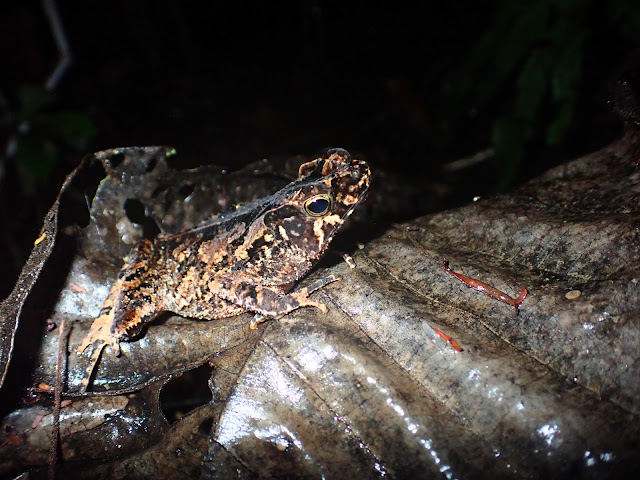






.jpg)



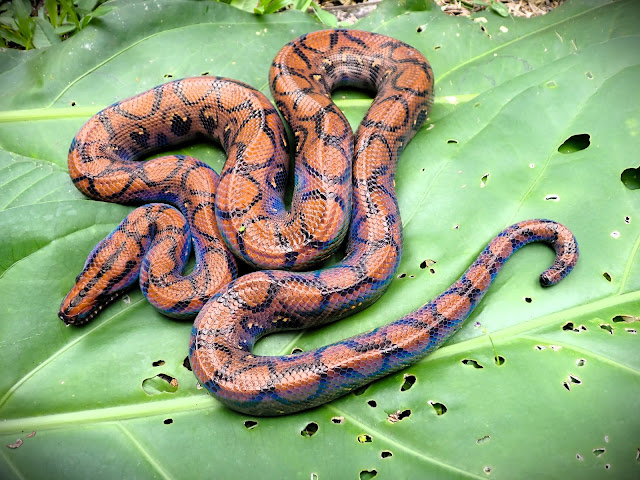














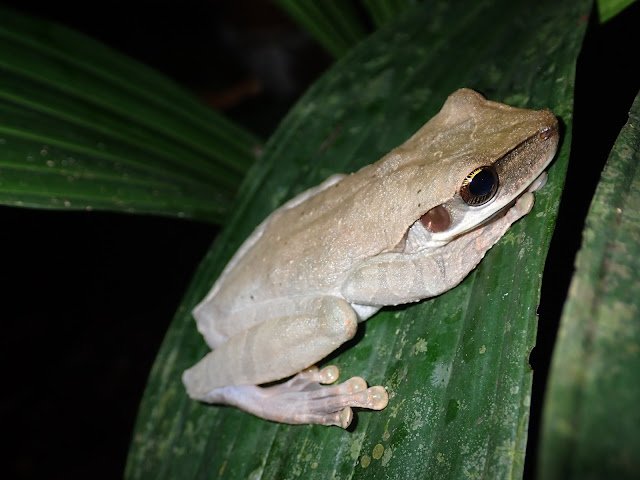




















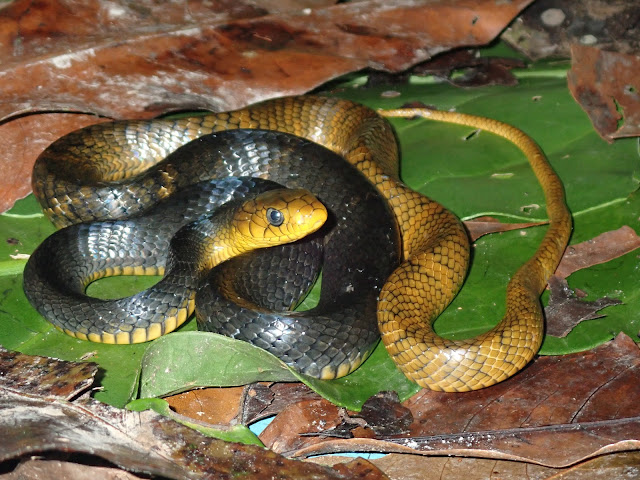


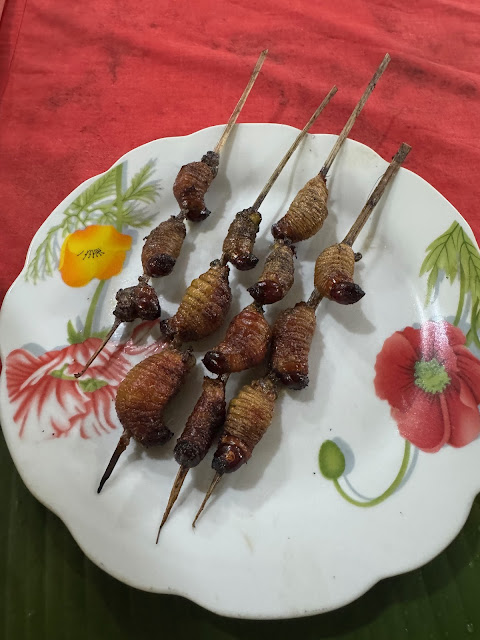

No comments:
Post a Comment